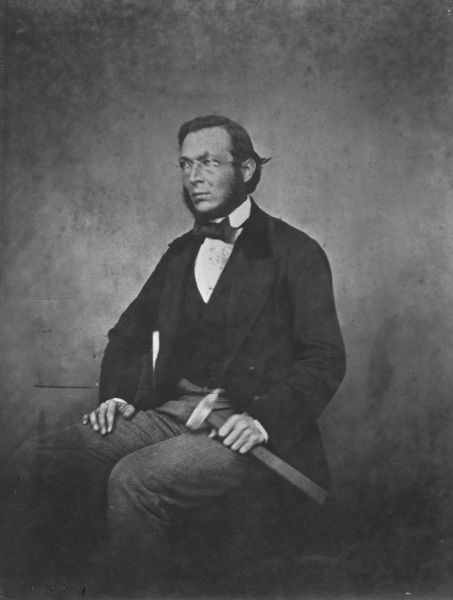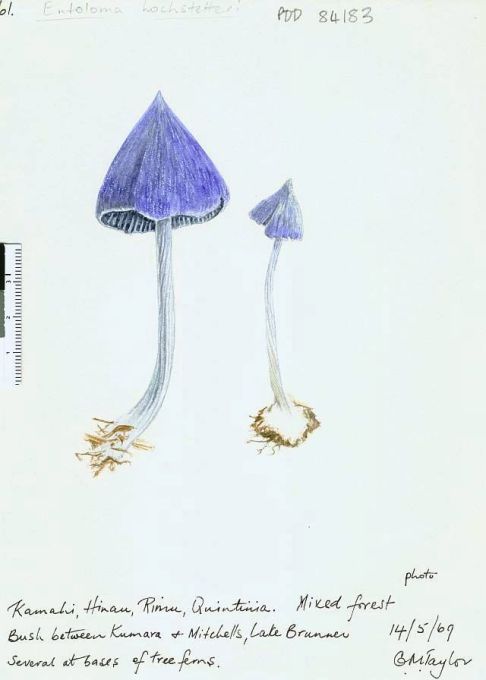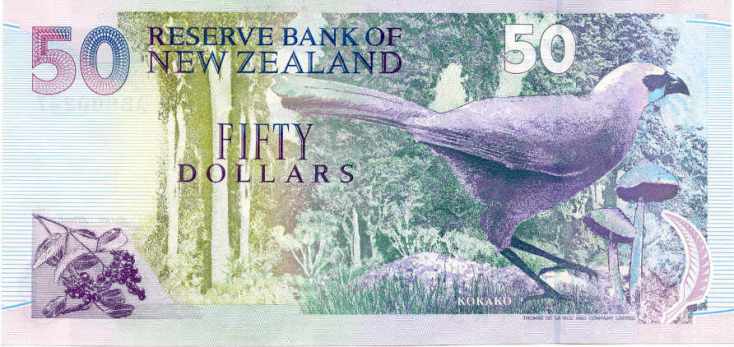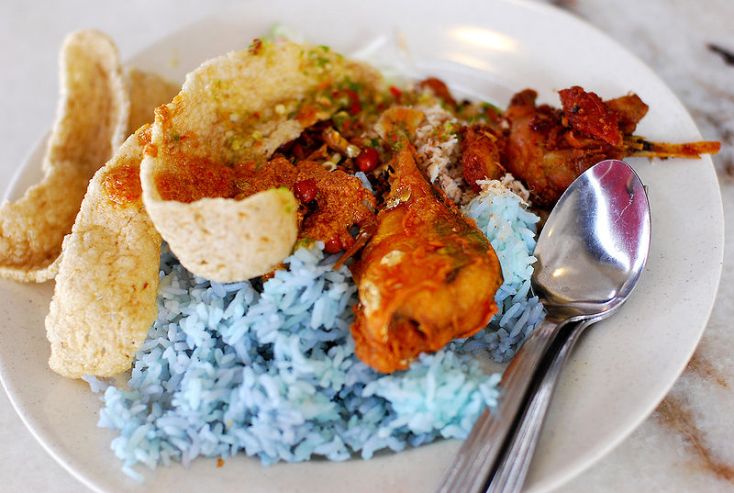Latin binomials can be scary enough to the beginner but when those names are the Latinised words from other languages it is even scarier. Take as an example the New Zealand blue pinkgill, Entoloma hochstetteri. Whoa! Where did that name come from and how do you say it? Most can cope with the Entoloma part of the name but in a predominantly English speaking nation why hochstetteri and how do you say it? The simplest pronunciation, although German speakers will shudder, is hock-shtetter-ree.
The blue pinkgill is named in honour of Christian Gottlieb Ferdinand von Hochstetter. Hochstetter was an Austrian geologist and naturalist who visited New Zealand in 1858 to 1860 (Fleming 1990, The Prow 2009). Although his work here was mainly geological he also made notes on natural history including fungi. On returning to Vienna he passed his notes including a drawing of this fungus to the mycologist Erwin Reichardt who describe it as Cortinarius hochsetteri in 1866.
For the first 60 years of the twentieth century there was almost no taxonomic investigation of the mushrooms of New Zealand. This drought was broken by a series of publication by Dr Greta Stevenson who in 1962 re-determined the blue pinkgill as Entoloma hochstetteri. Below is a plate from the 1962 paper with the blue pinkgill lower middle of the plate and numbered 7. The colours are muted due to the poor reproduction from the original art work by the printer and this was a great disappointment to Dr Stevenson.
Dr Stevenson’s papers kicked-off a new interest in mushrooms and further popularised through two small pictorial field guides by Marie Taylor. Below are Marie’s original water colours on which the illustrations in her books were based. These books brought awareness of the blue pinkgill to a much bigger audience and it became the ‘must find’ of new forayers. Mary Smiley wrote of her quest for the blue Entoloma of New Zealand in the American magazine Fungi. Mary wrote – crawling through the mud, wet leaves, sticker bushes, on my belly like a Navy Seal on a combat mission but all the while thinking “This is so much fun, I don’t ever want it to end!” and “… there were blue Entolomas everywhere …”.In the late 1980s the New Zealand Reserve Bank decided to completely revamp our banknotes. After wide consultation with the public the reverse side of the fifty dollar notes now features Pureora forest, the kokako (the blue wattled crow), supplejack whose fruits are eaten by kokako, and the blue pinkgill. As far as I know this is the only currency to feature a mushroom.
The reason for putting the blue pinkgill on the fifty dollar note is artistic in that the blue of the mushroom is similar to the blue wattles of the kokako. The similar colours was also noted by the Tuhoe people who call it werewere kokako or literally the kokako’s wattle (Best, 1942).
In 2002 New Zealand Post issued a set of stamps featuring native fungi with Entoloma hochstetteri on the 80c stamp. This was the first set of New Zealand stamps to feature fungi. The photos were taken by Don Horne.
Our interest in the blue pinkgill is possibly about to go culinary. The Metabolomics lab at the University of Auckland has been researching biological pigments to replace non-biological pigments used as food colourings. As they note:Food colouring now represents a $1.2 billion global market, with natural colours capturing 31% of the food market, but growing at a rate of 5%. However, these natural colours are largely plant extracts that have the disadvantage of variability and seasonal supply. Microbial cell production, in contrast, offers a reliable and scalable pigment production technology.
Entoloma species are very difficult to grow in artificial culture but the Metaboloic Lab now has the blue pinkgill in culture. It still has to be determined whether or not it has toxic or psychoactive properties. If it hasn’t then one day we may see kokako blue lollies or cosmetics.
The lead researcher Silas Villas-Boas jokes “that if it is edible, blue mushroom risotto could become an iconic New Zealand dish” (Gates, 2013) It would seem however that blue risotto is already a signature dish in Mallorca Spain and in Malaysia.
P.S. 16 July 2014. How we almost lost Hochstetter’s blue pinkgill!
In 1976 Egon Horak studying Entoloma species from around the world concluded Entoloma hochstetteri and the Japanese species E.aeruginosum was the same as an older named species E.virescens. As a result Barbara Segedin noted in 1988 “Hygrophorus cyaneus Berkeley, later called Entoloma hochstetteri by Stevenson and now called E. virescens, described first from Bonin Is., Japan”. Then the Japanese mycologist Tsuguo Hongo (1990) visited New Zealand in the late 1980s and studied both Entoloma hochstetteri and the Japanese species Entoloma aeruginosum and decided that they represented different species thus saving the name for us.
P.S. 20 March 2015. Banknotes redesign.
In November 2014 the Reserve Bank of New Zealand launched a new set of banknotes. Although redesigned they maintained the native biodiversity theme. Note that the blue pinkgill has moved from the lower right hand corner to centre stage.
ReferencesBest E 1942. Forest lore of the Maori. The kokako or crow. http://nzetc.victoria.ac.nz/tm/scholarly/tei-BesFore-t1-body-d2-d6-d16.html
Fleming CA 1990. Hochstetter, Christian Gottlieb Ferdinand von, (from the Dictionary of New Zealand Biography). Te Ara – the Encyclopedia of New Zealand, updated 30 October 2012. http://www.TeAra.govt.nz/en/biographies/1h30/hochstetter-christian-gottlieb-ferdinand-von
Gates C 2013. Mushrooms might yield major value. Stuff.co.nz http://www.stuff.co.nz/science/9354061/Mushroom-might-yield-major-value
Hongo T 1990. New and noteworthy agarics from New Zealand. Report from the Tottori Mycological Institute 28: 129-134.
Horak E 1976. On cuboid-spored species of Entoloma (Agaricales). Sydowia 28: 171-236.
Landcare Research. Flora, fauna and fungi on the other side of our new bank notes. http://www.landcareresearch.co.nz/about/news/blog/flora-fauna-fungi-bank-notes
Metabolomics Lab. Microbe-derived pigments. University of Auckland. http://www.metabolomics.auckland.ac.nz/index.php/home-top/14-projects-detail-cat/52-pigmentsdetail
New Zealand Post. Native fungi. http://stamps.nzpost.co.nz/new-zealand/2002/native-fungi
Reserve Bank of New Zealand. The history of banknotes in New Zealand. http://www.rbnz.govt.nz/notes_and_coins/notes/0094089.html
Segedin BP 1988. An historical view of the larger fungi. Auckland Botanical Society Journal 43: 23-24.
Smiley M 2010. Quest for the blue Entoloma of New Zealand. Fungi 3(4): 4-6. http://www.fungimag.com/fall-2010-articles/NewZealandLR.pdf
Stevenson G 1962. The Agaricales of New Zealand: III. Rhodophyllaceae. Kew Bulletin 16: 227-237 + plates 4-5.
The Prow 2009. Ferdinand Hochstetter (1829-1884). http://www.theprow.org.nz/people/ferdinand-hochstetter-1829-188/#.UpKDBF329D9

![Assorted Entoloma [Stevenson, 1962]](https://sporesmouldsandfungi.files.wordpress.com/2014/07/stevenson-entoloma-plate-2.jpg?w=479&h=778)







The blue pigment in Entoloma hochsteteri was anlaysed some tme ago and found to be Azulene and a couple of analogues. The was Work done in a PhD at canterbury in 1998.
http://pubs.rsc.org/en/Content/ArticleLanding/1999/NP/a705730j#!divAbstract
http://en.wikipedia.org/wiki/Azulene
Thanks Jerry, I had forgotten about Melvyn Gill work.
Geoff
I have had the Malaysian dish, nasi ulum, the blue rice is strange as we don’t often associate blue with edible. Very nice despite the unique colouring. I do remember the blue popsicles from childhood though.
So the blue pinkgill is edible then if they are going to use it as a food colouring source?
Have to say I have never noticed the mushroom on the $50. Will look next time. Life is in the details.
The note pictured above is the original paper note form the late 1980s. The current notes are plastic with transparent windows and other anti-counterfeiting devices so the mushrooms are somewhat squashed and obscured in the corner now.
Geoff
What fun to read your blog post on my favorite fungi of all time, the Blue Entoloma aka Entoloma hochstetteri. A friend of mine sent me a link to it and there was my name in your blog post referring to the story I wrote for Fungi Magazine. I never tire of seeing this fabulously beautiful jewel in nature and thank you for your interest in this fascinating little mushroom. There is simply nothing else like it in nature.
Cheers, Mary Smiley
Hi Mary
Your enthusiasm was too infective not to mention it in the blog.
Geoff
Oh and by the way, I’ve had your book for a while now. New Zealand has remarkable fungi.
Great article and feeling proud of our blue mushroom…
I remember the first time I saw these, and Archey’s frogs in the same piece of bush, and thinking is this really NZ?
I think people fail to appreciate that New Zealand biota is as ‘exotic’ as anywhere else in the world but usually just at a smaller scale.
Cheers
Geoff